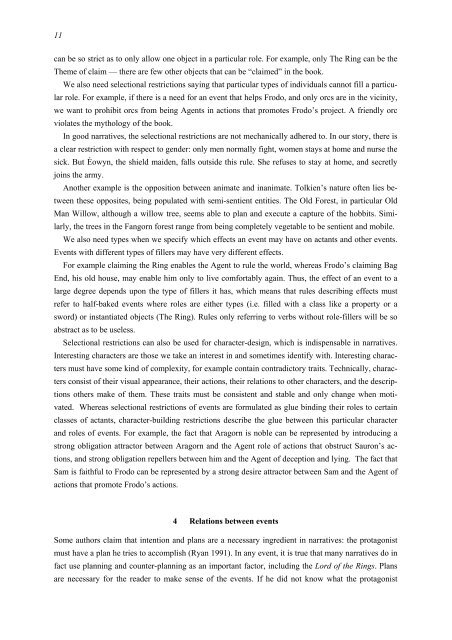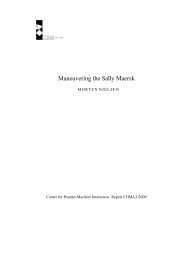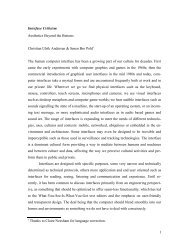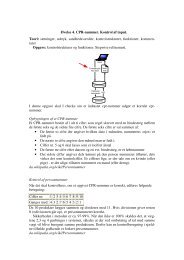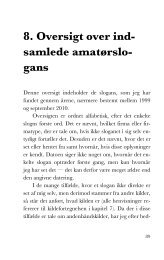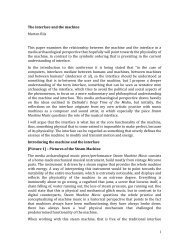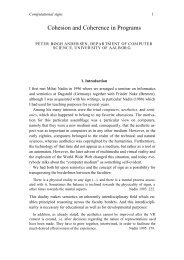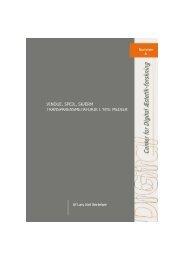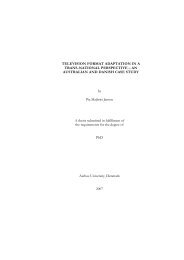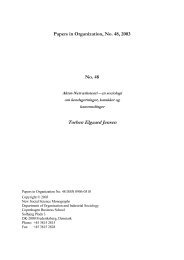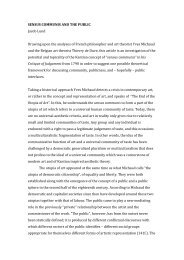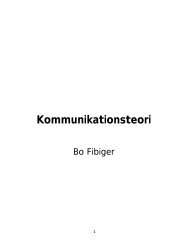Interaction and narration. Tearing Tolkien apart - CiteSeerX
Interaction and narration. Tearing Tolkien apart - CiteSeerX
Interaction and narration. Tearing Tolkien apart - CiteSeerX
Create successful ePaper yourself
Turn your PDF publications into a flip-book with our unique Google optimized e-Paper software.
11<br />
can be so strict as to only allow one object in a particular role. For example, only The Ring can be the<br />
Theme of claim — there are few other objects that can be “claimed” in the book.<br />
We also need selectional restrictions saying that particular types of individuals cannot fill a particular<br />
role. For example, if there is a need for an event that helps Frodo, <strong>and</strong> only orcs are in the vicinity,<br />
we want to prohibit orcs from being Agents in actions that promotes Frodo’s project. A friendly orc<br />
violates the mythology of the book.<br />
In good narratives, the selectional restrictions are not mechanically adhered to. In our story, there is<br />
a clear restriction with respect to gender: only men normally fight, women stays at home <strong>and</strong> nurse the<br />
sick. But Éowyn, the shield maiden, falls outside this rule. She refuses to stay at home, <strong>and</strong> secretly<br />
joins the army.<br />
Another example is the opposition between animate <strong>and</strong> inanimate. <strong>Tolkien</strong>’s nature often lies between<br />
these opposites, being populated with semi-sentient entities. The Old Forest, in particular Old<br />
Man Willow, although a willow tree, seems able to plan <strong>and</strong> execute a capture of the hobbits. Similarly,<br />
the trees in the Fangorn forest range from being completely vegetable to be sentient <strong>and</strong> mobile.<br />
We also need types when we specify which effects an event may have on actants <strong>and</strong> other events.<br />
Events with different types of fillers may have very different effects.<br />
For example claiming the Ring enables the Agent to rule the world, whereas Frodo’s claiming Bag<br />
End, his old house, may enable him only to live comfortably again. Thus, the effect of an event to a<br />
large degree depends upon the type of fillers it has, which means that rules describing effects must<br />
refer to half-baked events where roles are either types (i.e. filled with a class like a property or a<br />
sword) or instantiated objects (The Ring). Rules only referring to verbs without role-fillers will be so<br />
abstract as to be useless.<br />
Selectional restrictions can also be used for character-design, which is indispensable in narratives.<br />
Interesting characters are those we take an interest in <strong>and</strong> sometimes identify with. Interesting characters<br />
must have some kind of complexity, for example contain contradictory traits. Technically, characters<br />
consist of their visual appearance, their actions, their relations to other characters, <strong>and</strong> the descriptions<br />
others make of them. These traits must be consistent <strong>and</strong> stable <strong>and</strong> only change when motivated.<br />
Whereas selectional restrictions of events are formulated as glue binding their roles to certain<br />
classes of actants, character-building restrictions describe the glue between this particular character<br />
<strong>and</strong> roles of events. For example, the fact that Aragorn is noble can be represented by introducing a<br />
strong obligation attractor between Aragorn <strong>and</strong> the Agent role of actions that obstruct Sauron’s actions,<br />
<strong>and</strong> strong obligation repellers between him <strong>and</strong> the Agent of deception <strong>and</strong> lying. The fact that<br />
Sam is faithful to Frodo can be represented by a strong desire attractor between Sam <strong>and</strong> the Agent of<br />
actions that promote Frodo’s actions.<br />
4 Relations between events<br />
Some authors claim that intention <strong>and</strong> plans are a necessary ingredient in narratives: the protagonist<br />
must have a plan he tries to accomplish (Ryan 1991). In any event, it is true that many narratives do in<br />
fact use planning <strong>and</strong> counter-planning as an important factor, including the Lord of the Rings. Plans<br />
are necessary for the reader to make sense of the events. If he did not know what the protagonist


